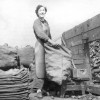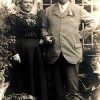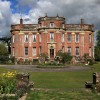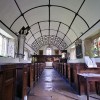Artist in Oils
In 1857 Joseph Clark submitted his first picture for the Royal AcademyExhibition, entitled The Sick Child; it was accepted. He exhibited regularly atthe Royal Academy and at the Royal Institution until a few years before hisdeath. In 1876 he was awarded a bronze medal at the Centenary Exhibition at Philadelphia. Then, in 1877 his painting Early Promise was purchased for the nation and a further painting Mother’s Darling was purchased for the nation in 1885; both paintings are held by the Tate. His first painting offered at auction realised £4.17s.6d, a high price for the time and his paintings continue to command good prices when they come up at auction today.
He was the son of a draper and calico bleacher, born at Cerne Abbas on the 4th of July 1834. His early education was at a Dame school, these small privateschools usually run by an elderly woman who taught the children to read and write before they were old enough to work. He was then enrolled at the Dorchester school run by William Barnes. A book has survived in which the young Joseph detailed various workings of geometrical problems and précis of lectures given by Barnes on divinity, English and Roman history, geography and geology. He developed an interest and aptitude for art, which was encouraged by Barnes.
Following the death of his father the family fortunes declined and he was removed from Barnes’ school to be apprenticed to a chemist at St. Neot’s in Huntingdonshire. He was not happy in his new position and returned to Cerne Abbas where he joined his mother, Susan, and his two older sisters, Mary and Emma, and their family servant, Jane Seard. Meanwhile, the family business had been taken on by his older brother William who had added a tailoring establishment.
The boy’s burning ambition was to go to London to continue his art studies and in this he received help from an unexpected quarter. His brother had employed a cutter to work in his tailoring shop; the man had come from London and he was a cultured individual who was familiar with the London art galleries and exhibitions. Having seen some of Joseph’s paintings he encouraged Mrs Clark to let Joseph go to London to further an artistic career.
On his arrival in London he wasted no time, immediately enrolling as a pupil at the school ran by James Leigh, located in Newman Street, which is just off Oxford Street. The school later became known as Heatherley’s; it still exists today. From Leigh’s school he progressed to the Royal Academy School then situated in the National Gallery building in Trafalgar Square.
By 1861 Joseph had been joined by his mother and the family servant, Jane. They all lived together at 25 Belle Vue Villas, Sussex Road, Islington, London. Thecensus confirms he had established himself as an ‘Artist in Oils.’
The next decade was a time of sorrow and happiness for Joseph. Early in 1866 his mother passed away having reached 76 years, her death being recorded inChristchurch. Towards the end of 1868 Joseph married Annie Jones, who was almost half his age. Her father was a Woolstapler from Winchester in Hampshire.
These two events suggest Joseph may have moved away from London for a while but by 1871 he was back in London, living at Arthur Road, Islington, with his young family and the faithful family servant, Jane. Jane Seard was now 60 and was assisted in her duties in the Clark household by a fourteen year-old girl, Emma Mills. A decade later we find Joseph and Annie Clark and their eleven year-old daughter, Annie, at 396 Holloway Castle, Islington. The couple enjoy the services of an elderly nurse and a young servant girl.
Then in 1891, after a space of fourteen years, the sound of young children can be heard again in the house. There are two more daughters and a son: Elsie was born in 1884; Wilfred in 1886 and Margaret in 1888. A 21 year-old governess, Harriet Eusor, was employed as well as a 23 year-old servant girl. Joseph Clark never seems to have needed an excuse to move house but his move to 23, Grosvenor Gardens, Hampstead, suggests more room was needed for his growing family and confirms he was a successful artist.
In 1901 we find Joseph and Annie with their four children at ‘Wenouree,’ Pinne Rd., Harrow-on-the-Hill. Their eldest daughter is teaching music and their son, Wilfred, is a Clerk to a Grain Broker. Joseph and Annie’s house moving continues but they stay, for now, north west of the metropolis and in 1911 they are in Uxbridge with two of their girls: Annie, who is still teaching music and the piano, and Margaret who is teaching at a private school.
Joseph Clarke died aged 92 years. He died on his birthday at Ramsgate in Kent, his death being registered in the Thanet district. Perhaps he had tired of north London and decided the Kent coast would be a nice place to live out his last years.
Like his parents, Joseph was a life-long member of the New Church, sometimes known as Swedenborgians. He served his church well as a Sunday school teacher and Church deacon as well as being a member of the Committee of Management.
In all his paintings he showed a feeling for family affection. All hispaintings express a love of family domesticity and portrayed moments of ordinary mans difficulties, sorrows and joys in his everyday existence. Many ofhis paintings had Barnes’ style captions, such as: Jeanes Wedden Day in Mornen (1879); Farmer’s Woldest Dater (1908) and Wedden Morn (1909).
He spent most of his life away from Dorset but he had with him those views and memories which had been so familiar to him in his youth and are suggested in many of his paintings.



